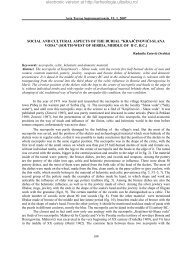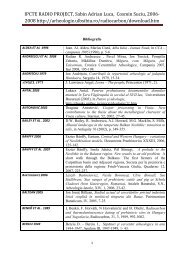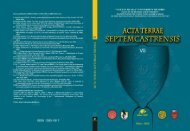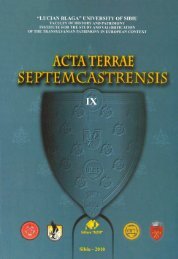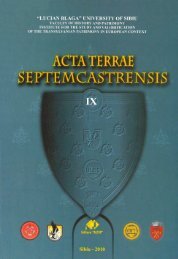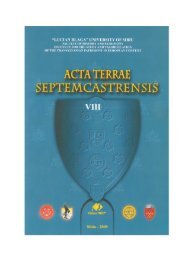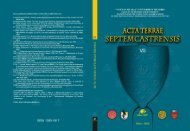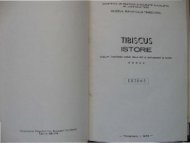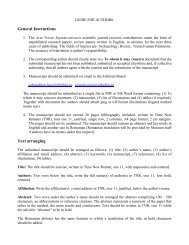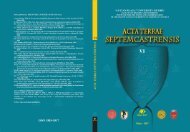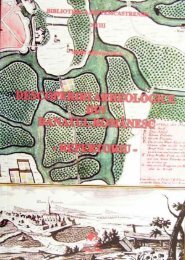acta terrae septemcastrensis viii - Institutul pentru cercetarea Åi ...
acta terrae septemcastrensis viii - Institutul pentru cercetarea Åi ...
acta terrae septemcastrensis viii - Institutul pentru cercetarea Åi ...
You also want an ePaper? Increase the reach of your titles
YUMPU automatically turns print PDFs into web optimized ePapers that Google loves.
Acta Terrae Septemcastrensis, VIII, 2009<br />
Social anthropology’s parameters<br />
Gaydarska and Chapman (2008: 63) understand social anthropology as a formal<br />
expression of power and status. However, social anthropology is a gigantic<br />
research field of positioning of the individuals and social groups in a variety of<br />
cultural contexts and analyzing their responses and interactions. Social<br />
anthropology always models personalities and identities that can be tested against<br />
different context but never limits to only one model since the context creates<br />
always more opportunities of explanation. The problem of power-status model is<br />
based on the presumption of absence of for instance, leading pure aesthetic,<br />
entertainment, memory or exotic functions of the prehistoric objects. Even if they<br />
exist, they would have secondary and dependent function (see the brilliant analysis<br />
of D.W. Bailey (2005) on prehistoric figurines).<br />
Then, Gaydarska and Chapman (2008) have limited their research approach to<br />
aesthetics within the power-status social model of understanding of the prehistoric<br />
objects, but at the same time in the following text even this determination is not<br />
explored because of the method of eclectically selected arguments.<br />
From the perspectives of Prehistory, the socioanthropological power-prestige<br />
model does not allow to analyze the aesthetic view in its completeness and<br />
connectiveness as an essential enculturational construct. It may better explain the<br />
interrelation between socialization and the aesthetic view.<br />
Art, aesthetic view and materiality<br />
It is impossible to follow the authors’ structure of arguments since they preferred a<br />
diachronic view on Balkan community but actually in the different selected<br />
periods are discussed different themes. Then, I will try to understand at least the<br />
main points as theoretical and not cultural-historical constructs.<br />
1. People and their environment<br />
According to Gaydarska and Chapman (2009: 65), “object-colors were as<br />
important as environmental colors in the creation of significance and meaning”.<br />
Unfortunately, I could not find any arguments in the body text of Gaydarska and<br />
Chapman that would be applied to the cited thought in the conclusions.<br />
My understanding is that this statement read in the conclusions is key for our<br />
perception of the prehistoric culture as a process that included art created to<br />
connect the people’s social life and nature but as an aesthetic and not as an<br />
aesthetical view (Nikolova, 2009; for the connectivity between art and archaeology<br />
see Bailey, 2008; cp. Iseminger, 2004, Parker 2005). I had shared with my students<br />
that when I was undergraduate student I spent an enormous time to try to<br />
understand the origin of art. As more as I read, more troubles I had in my<br />
understanding. Finally, even Dr Ivan Marazov in his lectures concluded that there<br />
are just many theories.<br />
The problem was that I read at that point about the origin of art in the library of the<br />
Art Academy and not in a library of Social Anthropology. In the former the<br />
9



